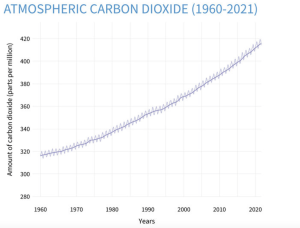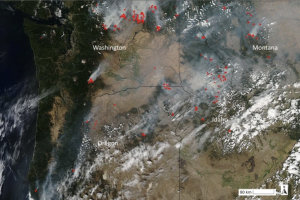4 Impacts of the Ecological Environment on Biodiversity
Ruo-Mei Liu
The whole passage is going to be about how carbon storage works and how it is interrelated with biodiversity specifically in the Pacific Northwest Forest. Furthermore, we are going to discuss how this relationship benefits the climate change situation and resolves it.
Carbon storage
Before talking about how the Pacific Northwest Forest helps resolve climate change, I would like to explain the detailed process of how forest, in general, reduces the effect of global warming. The answer is simple, but also not that simple. The forest performs carbon storage! Carbon storage is complex and “not that simple.” In order to store carbon, trees are required to perform the process of a whole set of reactions named photosynthesis. The whole photosynthesis process happened in the little pieces inside the trees-the leaves. Inside the leaves, there is an oval shaped object named the chloroplast. There are two sets of important reactions going on inside the chloroplast: light dependent and light independent reactions. Light dependent reactions take place within the membrane of the thylakoids, an object that stores chlorophyll inside chloroplast.[1] Photosystem II transports the excited election through the channel protein and attracts hydrogen inside thylakoids. Parts of the attracted hydrogens form NADPH from NADP+, which then transported to ATP synthase and produce ATPs, a critical element that provides energy in the Calvin cycle.[2] In addition, the leftover hydrogens form water. To illustrate, light dependent reactions generate ATPs and NADPHs. Following, light independent reactions, also known as the Calvin cycle, produce glucose through the use of carbon dioxide. There are three stages inside the Calvin cycle: carbon fixation, reduction of GDP, and regeneration of RuBP. Rubisco, a type of enzyme, fixes carbon dioxide into a three-carbon compound named GP. Next, by the use of ATP and NADPH, GP is reduced into G3P, which is a three-carbon compound linked with a hydrogen molecule. Glucose is produced within the process. Lastly, by utilizing the remaining ATPs, RuBPs are regenerated and oxygen gas is served as waste products and released into the air. The cycle continues on. To sum up, the whole process of photosynthesis generates oxygen and utilizes carbon dioxide. Also known as what we call “carbon storage.” To learn more about detailed carbon storage, please visit the chapter on “Carbon Storage in Forest.”
So what exactly does carbon storage do to biodiversity?
As the effects of climate change continues to expand, biodiversity in the Pacific Northwest forest has faced certain threats. Greenhouse gasses, which is carbon dioxide, tend to trap the heat of sunlight and store the energy within the atmosphere. This is essential for the environment because without warm temperatures we cannot survive. However, what causes the trouble is the excessive amount of carbon dioxide. Logging, transportation machines, and fossil fuels significantly increase the amount of carbon gasses. In fact, carbon gasses increased 100 times faster within the past 60 years.[3]

This enormous amount of carbon dioxide stores an excessive amount of heat, which causes the Earth to be overly heated. Due to the greenhouse effect, the climate has turned warmer which means certain species are not able to survive. Moreover, as a result of the dry, warm climate, cases of wildfires have significantly increased. Trees act as a comburent, thus a small wildfire could quickly spread and the magnitude exponentially grows, causing significant damage to the wilderness. The wildfires not only severely threatened the lives of animals, it also brought disturbance to the forest and terrible air pollution. A recent wildfire in Washington has caused horrible air pollution to Washington state.[4]

Right now, Washington state tends to have the worst air quality across the United States. In addition, the warm climate also brought drought to the forest. In 2015, an extreme dry year occurred, and a drought seems to appear in the rainforest.[5] These climate change effects have significantly reduced the biodiversity in Pacific Northwest forest. However, carbon storage did, actually, effectively relieve the situation. The Pacific Northwest forest stores more carbon than any forest around the world.[6] By trapping carbon, carbon dioxide cannot be released into the atmosphere. Consequently, the climate stops being warmer! Hence, species are able to survive and biodiversity could also be restored. In return, biodiversity contributes to the maintenance of a stable forest. A report posted on ScienceDirect uses the Simpson diversity metrics and calculated the biodiversity in the Pacific Northwest forest. They determined that ecosystem biodiversity shows positive interaction with the richness of trees and species.

In addition, in highly diverse ecosystems there tends to have higher biodiversity and that high biodiversity tends to reduce forest disturbance and positively influence the forest ecosystem.[7] The abundance of species supports a diverse food chain. Animals would not die because of a missing trophic level. The bodies of these organisms decompose in the soil and serve as an important factor that maintains soil stability. The microorganisms inside soil are essential for trees to gain nutrients and grow. Furthermore, more trees could survive and cases of soil erosion decrease simultaneously. Biodiversity and tree diversity contribute to each other and create a positive cycle. This cycle maintains a stable ecosystem. This is also exactly why we should try our best to preserve the forest, especially the Pacific Northwest forest, the major place of carbon storage. Of course, carbon storage in the forest does not only benefit biodiversity but also in other aspects. For more information, please refer to the chapter “Impacts of biodiversity in PNW forest with herbs as example.”
- “Light-Dependent Reactions (Photosynthesis Reaction) (Article).” Khan Academy, Khan Academy, https://www.khanacademy.org/science/ap-biology/cellular-energetics/photosynthesis/a/light-dependent-reactions. ↵
- Photosynthesis. National Geographic Society. (n.d.). Retrieved November 7, 2022, from https://education.nationalgeographic.org/resource/photosynthesis ↵
- Lindsey, R. (n.d.). Climate change: Atmospheric carbon dioxide. NOAA Climate.gov. Retrieved November 13, 2022, from https://www.climate.gov/news-features/understanding-climate/climate-change-atmospheric-carbon-dioxide ↵
- Halofsky, J. E., Peterson, D. L., & Harvey, B. J. (2020, January 27). Changing wildfire, changing forests: The effects of climate change on fire regimes and vegetation in the Pacific Northwest, USA - fire ecology. SpringerLink. Retrieved November 7, 2022, from https://link.springer.com/article/10.1186/s42408-019-0062-8 ↵
- Case, Michael J., et al. “Forests of the Future: Climate Change Impacts and Implications for Carbon Storage in the Pacific Northwest, USA.” Forest Ecology and Management, vol. 482, 2021, p. 118886–, https://doi.org/10.1016/j.foreco.2020.118886. ↵
- Potential Ecosystem Carbon Storage, https://www.esd.ornl.gov/projects/qen/carbon3.html. ↵
- Brandt, Patric, et al. “Multifunctionality and Biodiversity: Ecosystem Services in Temperate Rainforests of the Pacific Northwest, USA.” Biological Conservation, vol. 169, 2014, pp. 362–71, https://doi.org/10.1016/j.biocon.2013.12.003. ↵

